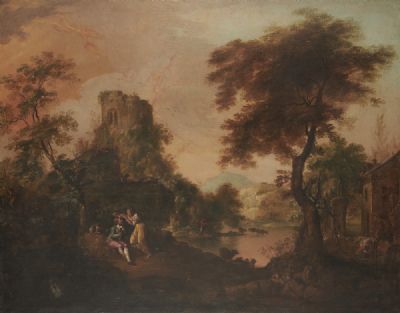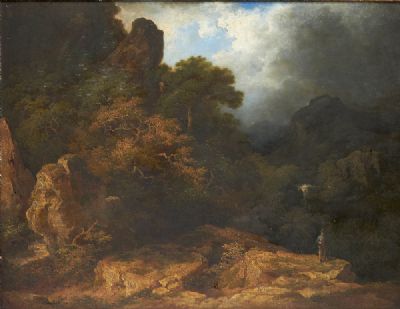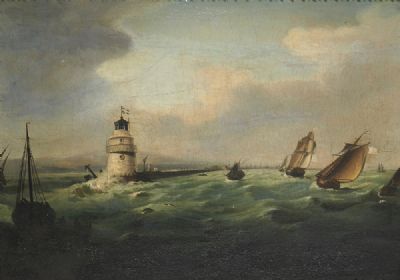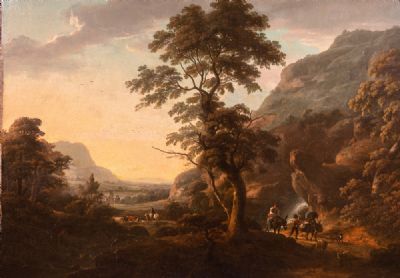Bidding on this item has ended.
George Barrett
A MOUNTAINOUS RIVER LANDSCAPE WITH FISHERMEN
Lot 53
Price Realised:
€40,000
Estimate:
€30,000 - €50,000
George Barrett Sr. RA, 1732-1784
A MOUNTAINOUS RIVER LANDSCAPE WITH FISHERMEN
Oil on canvas, 38" x 50" (97 x 127cm)
Landscapes from George Barret's Irish period - such as this large and impressive work - have often been appreciated more...
Read more
 Lot 53
George Barrett
A MOUNTAINOUS RIVER LANDSCAPE WITH FISHERMEN
Lot 53
George Barrett
A MOUNTAINOUS RIVER LANDSCAPE WITH FISHERMEN
 Lot 53
George Barrett
A MOUNTAINOUS RIVER LANDSCAPE WITH FISHERMEN
Lot 53
George Barrett
A MOUNTAINOUS RIVER LANDSCAPE WITH FISHERMEN
Estimate:
€30,000 - €50,000
George Barrett Sr. RA, 1732-1784
A MOUNTAINOUS RIVER LANDSCAPE WITH FISHERMEN
Oil on canvas, 38" x 50" (97 x 127cm)
Landscapes from George Barret's Irish period - such as this large and impressive work - have often been appreciated more than his later work in England where he found success and critical acclaim. A particular hallmark of his art at this juncture is his fondness for scenes showing fishermen, often, as here, with their clothing giving a highlight of red to the foreground. Barret was born in the Dublin Liberties however the date of his birth is confused, being variously given as 1728 and 1732. The later date (as given by Strickland) is the more probable. After a spell as an apprentice to a stay-maker he attended the Dublin Society Schools under the influential direction of Robert West, winning a prize in the 1747 examination. In the years immediately preceding his departure for London, Barret was exceptionally busy and was receiving patronage from the most exalted levels of Irish society. The increasingly substantial oeuvre from his years in Ireland that has been identified over the last decade or two, contradicts Strickland's assertion, paraphrasing Gilbert, History of Dublin, that Barret left Dublin for London as he was 'finding little encouragement in his art.' Certainly London offered wider scope for patronage but Barret was not lacking commissions, or inspiration, at home. Indeed he produced some of his finest paintings not in the cosmopolitan metropolis with the all the opportunities that it offered but in Dublin.
A relatively complete chronology for Barret's work in Ireland can now be pieced together, By the end of the 1740s he had received an important commission from Joseph Leeson to copy some works by Giovanni Battists Busiri which Leeson had purchased on his Grand Tour and to supplement these with a group of original landscapes to decorate the Library (now the Dining Room) at Russborough, County Wicklow. In addition, at an early stage in his career, he creatively adapted two works of Claude, probably for Samuel Madden one of the founders of the Dublin Society, in whose Schools the artist had studied.
Despite these early successes, it is in the following decade that Barret gradually develops his personal style. Two dated works from the 1750s are important here. The first, at Farmleigh, is dated 1755, and has been well characterised as being in the manner of Francesco Zuccarelli. A second, published by Michael Wynne, is also dated in the 1750s, however, the last digit of the date is illegible. In this several of the recurring structural characteristics of Barret's landscape art are already present and a series of impressive pictures may be grouped around it. These share the same basic composition. A dominating tree on the left of the composition; a waterfall or cascade near the centre, or just to the right of centre, and a distant view to mountains All are enlivened by diminutive figures, which evolve from rococo Italianate to the more substantial fishermen or travellers as seen in the present work.
In addition to his work at Russborough, during his time in Ireland Barret won patronage from Lord Powerscourt, the Conollys and the Taylours of Headford. In 1762, the year that Barret was working at Castletown where he is recorded in Lord Powerscourt's company, he was actively engaged in painting Powerscourt's famous demesne. He advertised, seeking subscriptions for engravings after four of his landscapes 'which were to be scraped, under his direction by John Dixon of Dublin'. The four views were to include: 'Powerscourt House and the Adjacent Country'; 'A View in the Dargle called the Castle Rock'; 'A View of the Dargle', and 'The Waterfall in Powerscourt Park', however, the project was never realised.
Gilbert records the relationship between Powerscourt and Barret 'who in early life passed much of his time at this nobleman's demesne in the county of Wicklow, the scenery of which formed the subject of many of his paintings'. Several of Barret's views of Powerscourt survive, at least two of Powerscourt House and four of the famous waterfall. These can all be dated with some certainty to the very early 1760s. His art at this juncture is a fruitful combination of the direct exposure to the scenery of the Wicklow Hills and Dargle Valley with his innate understanding of the classical landscape tradition and this is the context and date in which the present work is best situated. It is in early lush and romantic scenes such as this that Barret made his most original contribution to landscape art. Here there is a grandeur of conception and boldness of execution that led his friend James Barry to characterise Barret, with forgivable hyperbole, as 'a superior genius to Claude'. Mathew Pilkington, who probably knew the artist, summed up his style and sensibility well. 'Scarcely any painter equalled him in his knowledge or execution of the details of nature, the latter of which was particularly light, and well calculated to mark most decidedly the true characters of the various objects he represented, forest trees in particular'. Perhaps the last word should be given to Thomas Bodkin who, writing a century ago, noted that Barret was a painter 'of whom the Irish people have sound reason to be proud'.
William Laffan, 2022
A MOUNTAINOUS RIVER LANDSCAPE WITH FISHERMEN
Oil on canvas, 38" x 50" (97 x 127cm)
Landscapes from George Barret's Irish period - such as this large and impressive work - have often been appreciated more than his later work in England where he found success and critical acclaim. A particular hallmark of his art at this juncture is his fondness for scenes showing fishermen, often, as here, with their clothing giving a highlight of red to the foreground. Barret was born in the Dublin Liberties however the date of his birth is confused, being variously given as 1728 and 1732. The later date (as given by Strickland) is the more probable. After a spell as an apprentice to a stay-maker he attended the Dublin Society Schools under the influential direction of Robert West, winning a prize in the 1747 examination. In the years immediately preceding his departure for London, Barret was exceptionally busy and was receiving patronage from the most exalted levels of Irish society. The increasingly substantial oeuvre from his years in Ireland that has been identified over the last decade or two, contradicts Strickland's assertion, paraphrasing Gilbert, History of Dublin, that Barret left Dublin for London as he was 'finding little encouragement in his art.' Certainly London offered wider scope for patronage but Barret was not lacking commissions, or inspiration, at home. Indeed he produced some of his finest paintings not in the cosmopolitan metropolis with the all the opportunities that it offered but in Dublin.
A relatively complete chronology for Barret's work in Ireland can now be pieced together, By the end of the 1740s he had received an important commission from Joseph Leeson to copy some works by Giovanni Battists Busiri which Leeson had purchased on his Grand Tour and to supplement these with a group of original landscapes to decorate the Library (now the Dining Room) at Russborough, County Wicklow. In addition, at an early stage in his career, he creatively adapted two works of Claude, probably for Samuel Madden one of the founders of the Dublin Society, in whose Schools the artist had studied.
Despite these early successes, it is in the following decade that Barret gradually develops his personal style. Two dated works from the 1750s are important here. The first, at Farmleigh, is dated 1755, and has been well characterised as being in the manner of Francesco Zuccarelli. A second, published by Michael Wynne, is also dated in the 1750s, however, the last digit of the date is illegible. In this several of the recurring structural characteristics of Barret's landscape art are already present and a series of impressive pictures may be grouped around it. These share the same basic composition. A dominating tree on the left of the composition; a waterfall or cascade near the centre, or just to the right of centre, and a distant view to mountains All are enlivened by diminutive figures, which evolve from rococo Italianate to the more substantial fishermen or travellers as seen in the present work.
In addition to his work at Russborough, during his time in Ireland Barret won patronage from Lord Powerscourt, the Conollys and the Taylours of Headford. In 1762, the year that Barret was working at Castletown where he is recorded in Lord Powerscourt's company, he was actively engaged in painting Powerscourt's famous demesne. He advertised, seeking subscriptions for engravings after four of his landscapes 'which were to be scraped, under his direction by John Dixon of Dublin'. The four views were to include: 'Powerscourt House and the Adjacent Country'; 'A View in the Dargle called the Castle Rock'; 'A View of the Dargle', and 'The Waterfall in Powerscourt Park', however, the project was never realised.
Gilbert records the relationship between Powerscourt and Barret 'who in early life passed much of his time at this nobleman's demesne in the county of Wicklow, the scenery of which formed the subject of many of his paintings'. Several of Barret's views of Powerscourt survive, at least two of Powerscourt House and four of the famous waterfall. These can all be dated with some certainty to the very early 1760s. His art at this juncture is a fruitful combination of the direct exposure to the scenery of the Wicklow Hills and Dargle Valley with his innate understanding of the classical landscape tradition and this is the context and date in which the present work is best situated. It is in early lush and romantic scenes such as this that Barret made his most original contribution to landscape art. Here there is a grandeur of conception and boldness of execution that led his friend James Barry to characterise Barret, with forgivable hyperbole, as 'a superior genius to Claude'. Mathew Pilkington, who probably knew the artist, summed up his style and sensibility well. 'Scarcely any painter equalled him in his knowledge or execution of the details of nature, the latter of which was particularly light, and well calculated to mark most decidedly the true characters of the various objects he represented, forest trees in particular'. Perhaps the last word should be given to Thomas Bodkin who, writing a century ago, noted that Barret was a painter 'of whom the Irish people have sound reason to be proud'.
William Laffan, 2022
- Enquire
- View all lots by this artist
- How bidding works
Please note: You will require a deVeres account in order to bid. Please register via the website. Each lot will close numerically. If there is late bidding the time may be extended which could delay subsequent lots. The lots will start to close from 2.00pm on auction day, closing at 45 second intervals.
PLEASE BID EARLY TO AVOID DISAPPOINTMENT.
In order to allow rival bidders the opportunity to respond to a late bid the following extensions will apply:
IF A BID IS RECEIVED WITHIN THE FINAL 45 SECONDS OF THE COUNTDOWN THE CLOCK WILL RESET TO 60 SECONDS.
At any point you can leave a maximum bid, representing the highest price you are prepared to pay for a particular lot. Bidding only advances when there is competition from a rival bidder. In that case the system bids on your behalf, only up to the maximum if required. All bids are relayed to you be email, along with notification if you have been outbid.
All maximum bids are confidential and not disclosed. The system will endeavor to purchase the lot for you for the least price. Bids are subject to buyer’s premium of 25% (incl vat), with no additional charges.
In the event of a tied bid, the preference will be given to the bid submitted first. The second bidder will receive immediate notification of being outbid.
PLEASE BID EARLY TO AVOID DISAPPOINTMENT.
In order to allow rival bidders the opportunity to respond to a late bid the following extensions will apply:
IF A BID IS RECEIVED WITHIN THE FINAL 45 SECONDS OF THE COUNTDOWN THE CLOCK WILL RESET TO 60 SECONDS.
At any point you can leave a maximum bid, representing the highest price you are prepared to pay for a particular lot. Bidding only advances when there is competition from a rival bidder. In that case the system bids on your behalf, only up to the maximum if required. All bids are relayed to you be email, along with notification if you have been outbid.
All maximum bids are confidential and not disclosed. The system will endeavor to purchase the lot for you for the least price. Bids are subject to buyer’s premium of 25% (incl vat), with no additional charges.
In the event of a tied bid, the preference will be given to the bid submitted first. The second bidder will receive immediate notification of being outbid.
Sign-up to our auction alert
Signup for personalised Irish art recommendations, invitations to viewings and auctions, articles and more.

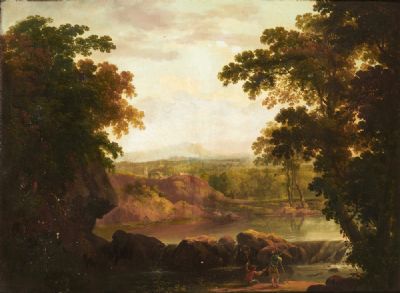
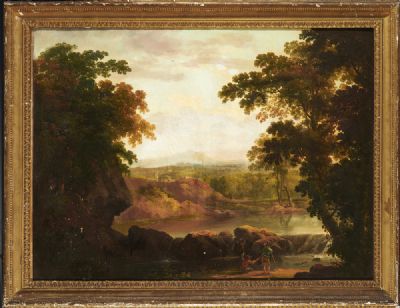
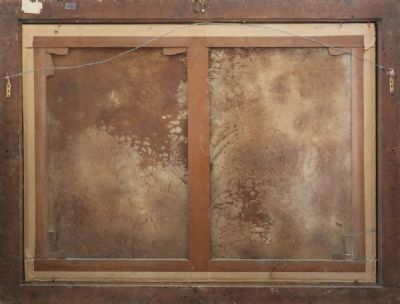
 View More Videos
View More Videos DVTV Click Here To View Video
DVTV Click Here To View Video